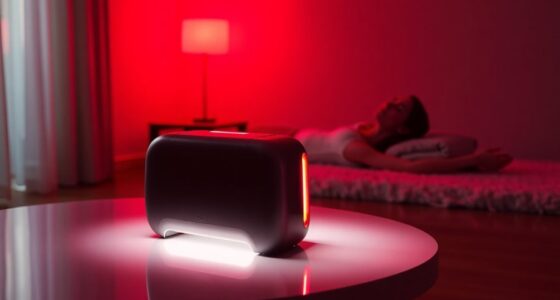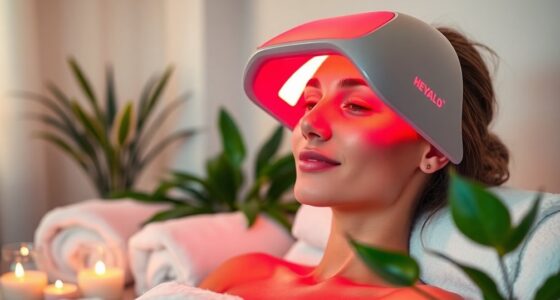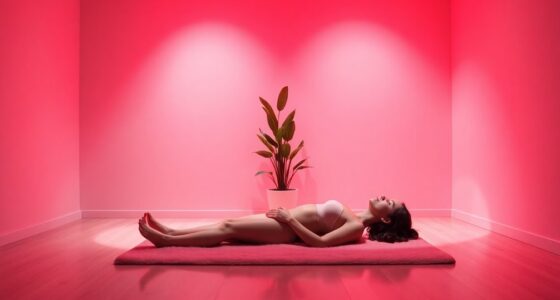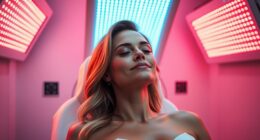For the best skin health, it’s generally recommended to use red light therapy after sun exposure. This allows the red light to support your skin’s natural healing and repair processes without increasing UV damage risk. Applying red light therapy post-sun helps soothe and restore your skin effectively. If you want to know more about balancing sun exposure and red light treatment, there’s helpful information to explore further.
Key Takeaways
- Prioritize sun protection (sunscreen, clothing, shade) before outdoor sun exposure to prevent skin damage.
- Use red light therapy after sun exposure to support skin healing and reduce inflammation.
- Applying red light therapy before sun exposure is less common and lacks strong evidence for benefits.
- Incorporate red light therapy into routines when not exposed to intense sunlight for maximum effectiveness.
- Balance sun safety with red light therapy to promote skin health without increasing damage risk.
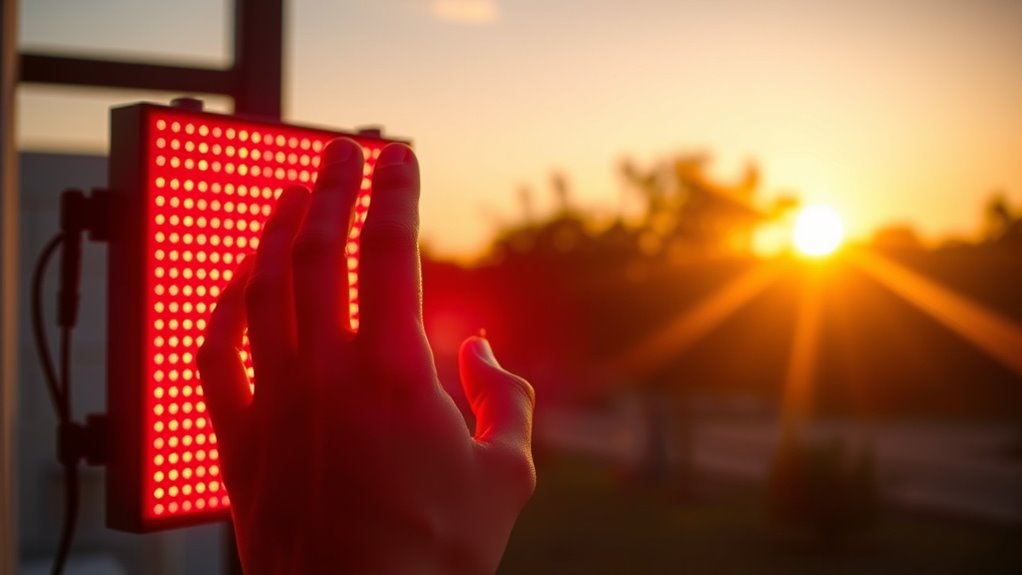
Red light and sun exposure both play significant roles in your skin’s health, but they influence it in very different ways. Sun exposure is natural and essential in moderation, helping your body produce vitamin D, which is indispensable for bone health and immune function. However, too much sun can damage your skin, causing premature aging, wrinkles, sunspots, and increasing your risk of skin cancer. Because of this, many people seek ways to protect their skin while still benefiting from sunlight. Red light therapy, on the other hand, is a controlled, safe treatment that uses specific wavelengths of red or near-infrared light to promote healing, reduce inflammation, and improve skin appearance. It doesn’t have the harmful UV rays associated with sun exposure and is often used to complement skincare routines or recovery processes.
When considering the best order for using red light therapy and sun exposure, it’s essential to understand their interactions. If you plan to spend time outdoors, it’s generally wise to prioritize sun protection first. Applying broad-spectrum sunscreen, wearing protective clothing, and seeking shade can shield your skin from harmful UV rays. After you’ve been outside, you might consider using red light therapy to support skin repair and rejuvenation. This approach allows your skin to benefit from the protective measures against UV damage while still leveraging the healing effects of red light afterward.
Alternatively, some people incorporate red light therapy before sun exposure, believing it can enhance skin resilience or prepare the skin for UV exposure. However, this is less common and not strongly supported by scientific evidence. Most experts recommend using red light therapy as a post-exposure treatment or as part of a regular skincare routine, rather than immediately before sun exposure. This is because red light can stimulate cellular activity and promote healing but doesn’t replace the need for sun protection.
It’s also worth noting that red light therapy can be used consistently regardless of sun exposure because it doesn’t increase your risk of skin damage. If you’re using red light regularly, it’s best to incorporate it into your routine at times when your skin isn’t exposed to intense sunlight. This way, you can maximize the benefits of both without compromising your skin’s health. Additionally, understanding the concept of spiritual energy can help you approach your skincare and health routines with a more holistic perspective, emphasizing balance and well-being. Ultimately, protecting your skin from excessive UV exposure remains paramount, and red light therapy is a safe, supplementary tool that can support your skin’s health when used thoughtfully. The key is balancing safe sun practices with the healing benefits of red light, ensuring your skin stays healthy and resilient over time.
Frequently Asked Questions
Can Red Light Therapy Replace Sun Exposure Benefits?
Red light therapy can’t replace the benefits of sun exposure entirely. Sunlight provides vitamin D, essential for your immune system, bone health, and mood, which red light therapy doesn’t deliver. While red light can support skin health and reduce inflammation, it doesn’t produce vitamin D. To optimize your health, enjoy safe sun exposure when possible, and use red light therapy as a complementary treatment rather than a substitute.
How Long Should I Wait Between Red Light and Sun Exposure?
Waiting wisely between red light therapy and sun exposure helps protect your skin. For ideal safety, wait at least 30 minutes after red light therapy before heading into the sun. This pause allows your skin to process the therapy’s benefits and reduces the risk of overexposure or irritation. By pacing your sessions, you preserve your skin’s health and maximize both treatments’ benefits, balancing brightness and brilliance safely and sensibly.
Is Red Light Therapy Safe Before or After Sunbathing?
It’s safest to do red light therapy before sunbathing. Red light can boost your skin’s healing and circulation, preparing it for sun exposure. If you do it afterward, your skin might be more sensitive, increasing the risk of irritation. Always listen to your body and consult with a healthcare professional if you’re unsure. This way, you enjoy the benefits safely and minimize any potential risks.
Are There Any Risks Combining Red Light and Sun Exposure?
Imagine your skin as a delicate canvas, vulnerable to overexposure. Combining red light therapy with sun exposure can increase risks like irritation, redness, or even burns if you’re not careful. Red light enhances blood flow and cell activity, while sun exposure adds UV stress. Together, they might overstimulate your skin, so it’s wise to space them out and protect your skin to avoid damage and maintain healthy, glowing skin.
Does Skin Type Affect the Optimal Order of Red Light and Sun Exposure?
Yes, your skin type influences the best order to use red light therapy and sun exposure. If you have fair or sensitive skin, it’s safer to do red light therapy first, as it prepares your skin and reduces sensitivity before sun exposure. For darker skin tones, you might reverse the order or adjust timing, but always listen to your skin’s response and consult a dermatologist for personalized advice.
Conclusion
In the end, it’s all about finding what works best for you. Whether you opt for red light therapy first or soak up the sun afterward, just remember to enjoy the process and listen to your body—like a true Renaissance soul. The key is balance, not pushing too hard or too soon. As the ancients might have said, “Moderation in all things,” for ideal health and radiance.


